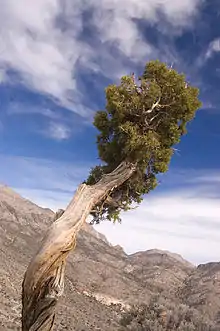Juniperus osteosperma
Juniperus osteosperma (Utah juniper; syn. J. utahensis) is a shrub or small tree reaching 3–6 m (rarely to 9 m) tall. It is native to the southwestern United States, in Utah, Nevada, Arizona, western New Mexico, western Colorado, Wyoming, southern Montana, southern Idaho and eastern California. It grows at moderate altitudes of 1,300–2,600 metres (4,300–8,500 ft), on dry soils, often together with Pinus monophylla.

| Juniperus osteosperma | |
|---|---|
 | |
| A Utah juniper showing distinctive shape and leaves | |
| Scientific classification | |
| Kingdom: | Plantae |
| Clade: | Tracheophytes |
| Division: | Pinophyta |
| Class: | Pinopsida |
| Order: | Pinales |
| Family: | Cupressaceae |
| Genus: | Juniperus |
| Species: | J. osteosperma |
| Binomial name | |
| Juniperus osteosperma | |
 | |
| Natural range | |
The shoots are fairly thick compared to most junipers, 1.5–2 mm diameter. The leaves are arranged in opposite decussate pairs or whorls of three; the adult leaves are scale-like, 1–2 mm long (to 5 mm on lead shoots) and 1–1.5 millimetres (0.039–0.059 in) broad. The juvenile leaves (on young seedlings only) are needle-like, 5–10 mm long. The cones are berry-like, 8–13 millimetres (0.31–0.51 in) in diameter, blue-brown with a whitish waxy bloom, and contain a single seed (rarely two); they mature in about 18 months and are eaten by birds and small mammals.[2] The male cones are 2–4 millimetres (0.079–0.157 in) long, and shed their pollen in early spring. It is largely dioecious with both sexes on the same plant, but around 10% of plants are monoecious, producing cones of only one sex.

The plants frequently bear numerous galls caused by the Juniper Tip Midge Oligotrophus betheli (Bibionomorpha: Cecidomyiidae); these are conspicuous pale violet-purple, produced in clusters of 5–20 together, each gall 1–2 centimetres (0.39–0.79 in) diameter, with dense modified spreading scale-leaves 6–10 millimetres (0.24–0.39 in) long and 2–3 millimetres (0.079–0.118 in) broad at the base.
Seeds are dispersed by a variety of mammals and birds. Mammals include jackrabbits (mostly the black-tailed jackrabbit Lepus californicus spp.) rodents and to a lesser extent by coyotes (Canis latrans).[3] Most notable among the birds that disperse juniper berries is the Townsend's Solitaire (Myadestes townsendi).[4]

Native Americans such as the Havasupai used the bark for a variety of purposes, including beds, and ate the cones both fresh and in cakes.[5] The Havasupai used the gum to make a protective covering over wounds. Additionally, the Yavapai gave their women a tea made from the leaves to calm their contractions after giving birth, and fumigated them with smoke from the leaves placed over hot coals. The Navajo sweep their tracks with boughs from the trees so death will not follow them.[6]
A small quantity of ripe berries can be eaten as an emergency food or as a sage-like seasoning for meat. The dried berries can be roasted and ground into a coffee substitute.[7]
Utah juniper is an aromatic plant. Essential oil extracted from the trunk and limb is prominent in α-pinene, δ-3-carene, and cis-thujopsene. Essential oil extracted from the leaf is prominent in camphor and bornyl acetate.[8]
See also
References
- Farjon, A. (2013). "Juniperus osteosperma". IUCN Red List of Threatened Species. 2013: e.T42241A2965708. doi:10.2305/IUCN.UK.2013-1.RLTS.T42241A2965708.en.
- Little, Elbert L. (1994) [1980]. The Audubon Society Field Guide to North American Trees: Western Region (Chanticleer Press ed.). Knopf. p. 317. ISBN 0394507614.
- Chambers, Jeanne C.; Vander Wall, Stephen B.; Schupp, Eugene W. (January 1999). "Seed and seedling ecology of piñon and juniper species in the pygmy woodlands of western North America". The Botanical Review. 65 (1): 1–38. doi:10.1007/bf02856556. ISSN 0006-8101. S2CID 38377131.
- Poddar, Saradell; Lederer, Roger J. (July 1982). "Juniper Berries as an Exclusive Winter Forage for Townsend's Solitaires". American Midland Naturalist. 108 (1): 34. doi:10.2307/2425289. ISSN 0003-0031. JSTOR 2425289.
- Whitney, Stephen (1985). Western Forests (The Audubon Society Nature Guides). New York: Knopf. p. 371. ISBN 0-394-73127-1.
- Peattie, Donald Culross (1953). A Natural History of Western Trees. New York: Bonanza Books. pp. 265–66.
- Elias, Thomas S.; Dykeman, Peter A. (2009) [1982]. Edible Wild Plants: A North American Field Guide to Over 200 Natural Foods. New York: Sterling. pp. 194, 197. ISBN 978-1-4027-6715-9. OCLC 244766414.
- Wilson TM, Poulson A, Packer C, Marshall J, Carlson RE, Buch RM. "Essential oils of whole tree, trunk, limbs and leaves of Juniperus osteosperma from Utah". Phytologia. 101 (3): 188–193.CS1 maint: multiple names: authors list (link)
External links
| Wikimedia Commons has media related to Juniperus osteosperma. |
- USDA Plant Profile: Juniperus osteosperma
- Gymnosperm Database: Juniperus osteosperma
- Flora of North America: Juniperus osteosperma
- Jepson Manual - Juniperus osteosperma
- Juniperus osteosperma - Photo Gallery
- Conifer Specialist Group (1998). "Juniperus osteosperma". IUCN Red List of Threatened Species. 1998. Retrieved 12 May 2006.CS1 maint: ref=harv (link)
- Interactive Distribution Map of Juniperus osteosperma
